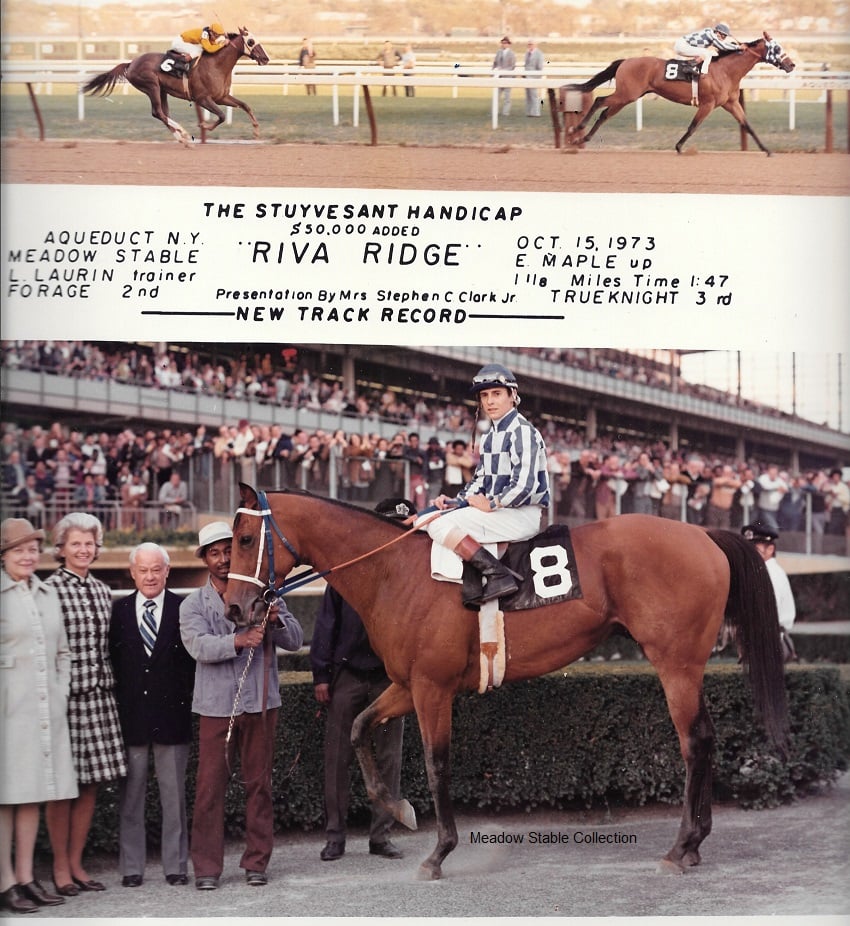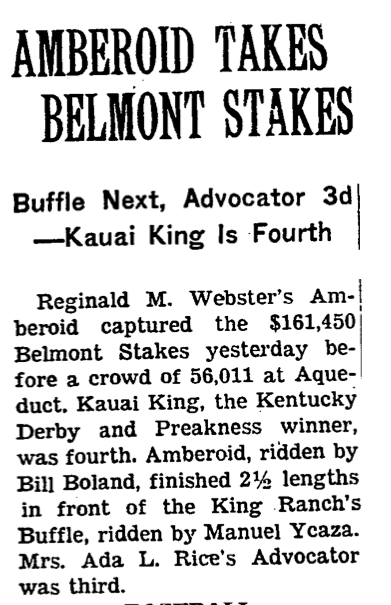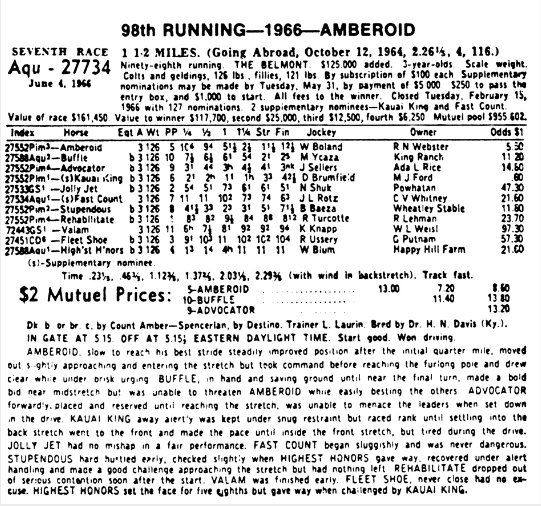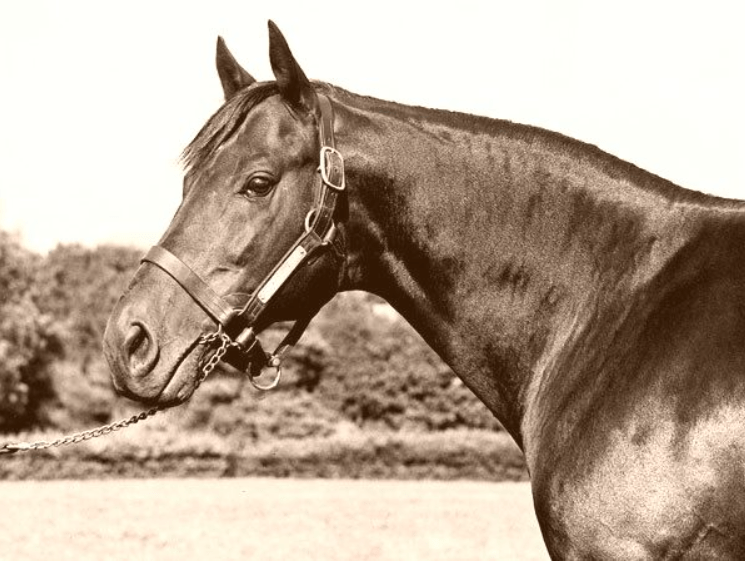Everyone knows Lucien Laurin’s story. With Bull Hancock’s assistance Penny Chenery plucked the quirky trainer reluctantly out of retirement to train her “big red” colt.
Wait, that was only in the movies. The actually story goes Laurin’s son Roger was working as a trainer at the Meadow for Christopher Chenery and when Roger accepted an offer to work for Ogden Phipps, the younger Laurin suggested his father come to the Meadow.
The elder Laurin went to the Meadow Stables in 1971 on what was to be a temporary basis. The farm, having some financial difficulties, seemed to have found their lucky charm.
The Angel of The Meadow
On April 13, 1969, a foal arrived at the Meadow that would seal its future. But the stars would need to align, and Laurin was one of those stars. The Chenery’s welcomed a leggy bay colt sired by the appropriately named stallion First Landing (Turn-To {IRE}). He was out of Heliopolis mare Iberia. And his name was Riva Ridge.
Riva Ridge’s name came from Chenery’s son-in-law, John Tweedy, who was a soldier in World War II at the important strategic victory by the U.S. Army’s 10th Mountain Division on February 18, 1945, at Riva Ridge in the North Apennine mountains of Italy.
By the time Laurin arrived at the farm Riva Ridge had grown into a sleek, striking light bay with long black legs. The colt had also developed a keen mind and relaxed disposition.
Riva Ridge made his debut on June 9, 1971, at Belmont Park. Despite going off at 2-1 odds, Riva Ridge was bumped at the start and finished seventh. With blinkers added, he then won in both maiden and allowance company, having broken on the lead in both races. In his stakes debut in the Great American Stakes, he again disappointed as the favorite, finishing eighth.
For his next start in the Flash Stakes at Saratoga Race Course, Riva Ridge benefited from a jockey change. Enter Ron Turcotte into the story (Yup, that’s not how it happened in the movie either.)
In the Flash, Turcotte took complete control of the young colt and when Riva Ridge tried to bolt to the outside following the break Turcotte guided him back to the rail. The pair would score a 2 1⁄2 length victory.
Reflecting on the Flash Stakes behavior, Turcotte realized that Riva Ridge had a fear of close quarters caused by the difficult start in his first race. Being a jockey who was supersensitive to his mounts, Turcotte asked Laurin if Riva Ridge could take a month’s break to work on his fear—of the starting gate for one.
With plans for Riva Ridge to run in other races at Saratoga, Laurin initially declined Turcotte’s request. “You can have a champion or a claimer. It’s your call,” said Turcotte insisting that a month would make a huge difference in Riva Ridge’s future on the track. Laurin finally agreed to allow Turcotte to work Riva Ridge in company. They used stable ponies at first and then two other horses from Laurin’s barn.
The plan was to run Riva Ridge in the Hopeful Stakes when Turcotte felt he was ready. Unfortunately, Riva Ridge came down with a fever a few hours before the race and had to be scratched. Once the colt bounced back things began to click. Turcotte’s idea worked. Riva Ridge had matured with greater confidence and won four consecutive stakes in the fall of 1971, netting him honors as that year’s 2-year-old champion.
Laurin only entered Riva Ridge in three races Kentucky Derby before, something unusual in the early 1970s.
In his 3-year-old debut, Riva Ridge had a good start winning the Hibiscus at Hialeah. In the Everglades again at Hialeah, he faced a sloppy track and did not fare well finishing fourth. This is something that would come back to haunt him.
The colt would bounce back and win the Blue Grass at Keeneland nine days before the Kentucky Derby.
The morning of the Derby Turcotte was concerned that Riva Ridges blinkers might impede his vision should he be asked to go to the front early in the race. He asked Laurin if he could cut larger holes in Riva Ridge’s blinkers. Thinking a test run would have been better Laurin relented.
As Turcotte expected his mouth went to the lead early, holding it throughout the race to go gate-to-wire and win by 3 1⁄4 lengths.
The favorite at 1-5, Riva Ridge faced a sloppy track in Baltimore as he had done in the Everglades at Hialeah and he would again finish fourth this time to longshot Bee Bee Bee. It was apparent the sleek bay was not suited to an off track. And Laurin’s hopes of a Triple Crown washed away in the sloshy Pimlico track.
With a bit rest after three races in 23 days, Riva Ridge defeated nine other horses with a seven-length victory in the 1 1⁄2-mile Belmont Stakes.
Later in his three-year-old season, Riva Ridge won the Hollywood Derby by a nose, but then suffered five straight losses, two of which were to eventual champion three-year-old male Key to the Mint.
After freshening up and training well in July, Riva Ridge’s first race following the Hollywood Derby was the Monmouth Invitational. Before his fourth-place finish, Laurin and Penny Chenery thought he was unusually docile in the saddling paddock. Turcotte described him as having been “dull” in the post parade.
When Riva Ridge returned to Saratoga the day after, he tested positive for traces of a tranquilizer derivative, indicating someone had likely given him a tranquilizer between 8 and 48 hours before the race.
Penny Chenery Tweedy told the New York Times Riva Ridge was under the effects of a tranquilizer when he ran fourth in the Monmouth Invitational at Monmouth Park on Aug. 5.3
Tweedy said that after the colt had returned to Saratoga following his defeat in the race, she and Lucien Laurin were dissatisfied with the horse’s appearance and attitude and sent specimens of blood and urine to the Dalare Laboratories in Philadelphia the day after the race.
The results of the analyses showed positive existence of Phenothiazine, or a tranquilizer derivative thereof, according to Tweedy.
These results were received on Monday, Aug. 7 and Tweedy said Monmouth Park officials were immediately informed as well as the Federal Bureau of Investigation and the Thoroughbred Racing Protective Bureau. However, Riva Ridge was not tested immediately after the race by officials and the levels reported were not grounds for any action.
On September 20, Riva Ridge lost the Stymie Handicap by a neck to Canonero II, winner of the 1971 Kentucky Derby and Preakness. For the rest of the year, he was off the board in his final three starts, all over off tracks or turf not on his preferred dirt surface.
At age four, Riva Ridge developed a kidney condition and a chronic shoulder issue, but still won five of the his nine starts, set four track records, and equaled the 11⁄8-mile track record at Suffolk Downs in winning the Massachusetts Handicap. His winning time of 1:522⁄5 in the Brooklyn Handicap (raced that year at Aqueduct Racetrack) set a world record for 13⁄16 miles on the dirt. His mark was equaled by Farma Way in 1991 at Pimlico Race Course. Their record still stands today.
With much fanfare, the Philip Morris Tobacco Company sponsored what was to be a match race with stablemate Secretariat. After both horses were beaten in preparatory races for the match, it was changed to an invitational race.
In record time, and both wearing the blue and white checks of Meadow Stable, Secretariat, ridden by Turcotte, finished first and Riva Ridge, ridden by Eddie Maple, finished second. Both horses surpassed the world record time, though only Secretariat received credit due to his first-place finish.

After the death of Christopher Chenery in January 1973, Riva Ridge and Secretariat were both sold to breeding syndicates and retired to stud at Bull Hancock’s Claiborne Farm at the end of the 1973 racing season. Riva Ridge was syndicated for $5.12 million, and Secretariat for $6.08 million.
Riva Ridge would always lived in Secretariat’s shadow. Except for Penny Chenery.
Penny Chenery often came back to visit both horses, but over time Secretariat would no longer acknowledge her due to the many visitors he got. Riva Ridge, however, developed a stronger bond with Penny since he was largely overlooked by the general public. “There was never a time when Riva wouldn’t come up to me to say hello,” she later said in an interview.2
Out of Riva Ridge’s 360 named foals, 228 were winners, including 29 stakes winners. Of his notable progeny is Blitey who proved to be an amazing racemare and broodmare. On the track Blitey had a career record of 23 Starts: 8-5-5, with earnings of $297,746 with wins including the Test S., Maskette S., and Ballerina S. As a broodmare she produced a Ballerina winner, Furlough, and 11 other stakes winner.
Another, Tap Shoes, a chestnut who had a record of 22 Starts: 8-4-3, with earnings of $463,513 and upon retirement stood at Rocketts Mill Farm, near Doswell Virginia before being sent to Brazil in 1992.
Riva Ridge died of a heart attack in his paddock on April 21, 1985, after a trip to the breeding shed. Claiborne staff saw him fall over in his paddock and immediately rushed over to him, but he had died by the time he hit the ground. He was 16 years old.
As we know, Secretariat did indeed with the Preakness Stakes as did his sire, Bold Ruler. Big Red went on to sire his own Preakness winner, 1988 champ Risen Star, who also won two of the three legs of the Triple Crown which included the Belmont Stakes.
The 1966 Belmont Stakes
1966 was supposed to be Kauai King’s year. The Native Dancer colt had already won the Kentucky Derby, a feat his sire had failed to do, and the Preakness Stakes, in the hoofsteps of his sire. He was the preemptive Belmont champ going into the third leg of the Spring Classics therefore a Triple Crown winner.
But Kauai King was not to wear the three-jeweled crown that year for there would be an interloper. And his name was Amberoid.
1966 was an exceptional year for 3-year-old Thoroughbreds. The likes of Graustark and Buckpasser, future Horse of the Year, would have been Kauai King’s main competition in the Belmont Stakes if not for injury and circumstance.
Foaled in Kentucky, Amberoid was named for the synthetic form of amber, fossilized tree resin used as a semi-precious gemstone in jewelry.
A dark bay resembling his prolific French-bred grandsire, Amboirix, Amberoid was bred by Dr. Horace N. Davis, Jr., a veterinarian and owner of the Thoroughbred Horse Farm, Bluegrass Height. The leggy colt with the elegant neck and head was owned by Reginald N. Webster.
Reginald Webster, born in Dublin, Ireland, became an American businessman and Thoroughbred racehorse owner after his family emigrated to the United States when he was a little boy.
He was president of the precisions parts manufacturer Standard-Thomson Corp. of Waltham, Mass., until the company’s takeover in 1974 whereas he retired.
Becoming involved in racing in 1945, Webster hired Lucien Laurin in 1947 as his conditioner. Their best success was Amberoid’s 1966 Belmont victory.
Webster also raced horses in England and Ireland. His Irish-bred colt Martial, son of Hill Gail, trained by legendary trainer Paddy Pendergast, won the 1960 2,000 Guineas at Newmarket and the Coventry Stakes at Ascot. Webster was one of only a few Americans to win both an American and British Classic.
With wins including the Matron, Acorn and Mother Goose Stakes, Webster’s filly Quill was voted 1958 Champion 2-year-old fill. Other notable horses were Traffic, National, Artfully and Pearl Necklace.
Reginald Webster was a member of The Jockey Club and served as president of The Thoroughbred Owners and Breeders Association. Webster died in Palm Beach, Fla. At the age of 85.
Amberoid didn’t have a front-running style, but he had a nice turn-of-foot and the heart to win rallying off the pace.
According to Equibase, as a two-year-old he placed in his first stakes at Saratoga, the Flash Stakes, August 2, 1965. Amberoid would finish third in his next two stakes, the Pimlico Futurity November 13, and the Garden State Stakes seven days later. December 1 the colt would again place in the Remsen at Aqueduct.
He carried weighted at 117 pounds on the Experimental Free Handicap for American juveniles of 1965, 9 pounds below champion Buckpasser.1
As a 3-year-old, he began with a second in the Fountain of Youth at Gulfstream March 23 followed with his first stakes win at Aqueduct in the Wood Memorial April 23. Next, he would head for the Triple Crown, Lucien Laurin’s future domain.
Laurin’s debut in the Triple Crown would be lackluster.
In the Kentucky Derby, Amberoid finished seventh, but he was only four lengths behind Kauai King, and at the start of the Derby he went to his knees coming out of the gate, all but spilling Jockey Bill Boland.
With Hall of Famer Bill Boland up Amberoid would finish seventh in the Kentucky Derby to Kauai King in a field of 15. Amberoid finished seventh, but he was only four lengths behind Kauai King, and at the start of the Derby he went to his knees coming out of the gate, all but spilling Boland.
Two weeks later, the plucky colt would run in the Preakness Stakes in a field of nine, seven of which, including Amberoid, ran in the Kentucky Derby. He was also running against the Derby champ, Kauai King. The son of Native Dancer, Kauai King fulfilled his sires one loss.
Amberoid was third in the Preakness by a length and a half. “In both of those races,” said Trainer Laurin, “we were too far back in the early running, and unless you stay up closer to a colt like Kauai King you have no chance of picking him up in the stretch.”
Amberoid wasn’t really on anyone’s radar to win the Belmont. He had won only one of his seven starts that year and had a modest three wins in 16 lifetime starts. However, the Laurin trainee went off as second choice at 5-1.
The longest of the three Classics, Laurin’s colt was conditioned well and exhibited good stamina for the course. The Belmont Stakes was held at Aqueduct that year. Laurin and Amberoid had an asset on their side: Kauai King had never started at Aqueduct, whereas Amberoid ran his finest race to date there when he won the Wood Memorial in April.
“No question about it,” said Laurin. “Amberoid loves Aqueduct. This isn’t a cuppy track, and he can take a real good hold of it. The extra distance will suit him perfectly—if he doesn’t get too far behind at the start.”4
As the start grew nearer the crowd of 56,011 at Aqueduct was sure they had a Triple Crown winner. The excitement was palpable. Would Kauai King snap the 18-year Triple Crown drought?
As expected Cortwright Wetherill’s Highest Honors who could not be rated and broke first and went to the lead. The pace would be his for as far as his speed and stamina could carry him. Stupendous and Kauai King were strategically just off the leader awaiting an opportunity. The cluster contenders who were lengths behind the leaders were attempting to gain position while saving speed for the last quarter.
Highest Honors opened up four lengths as the field headed up the backstretch, but Kauai King and Stupendous were well within range, while Advocator was a comfortable fourth and Buffle well placed in sixth position. Amberoid, saving ground all the time, was ninth.
Kauai King, although always very willing, can also be very rank, particularly at the start of a race. Usually running with his tongue hanging out and his head sharply cocked, this time his whole length was twisted nearly sideways with Brumfield all but powerless to keep him under control.
When Highest Honors folded after a mile, Brumfield had Kauai King in front—which is where Brumfield did not want to be so early in a mile-and-a-half race. As Brumfield’s charge took the lead even before the field had reached the five-eighths pole, everyone felt that he would never last, including his pilot.
The slow starter, ninth and then fifth after a mile, Amberiod rolled around the field in an amazingly courageous move that brought him just behind Kauai King at the head of the stretch. As Amberiod sailed past the favorite the crowd instinctively knew the race was his. Only Buffle, ridden by Manuel Ycaza, gave a game challenge over the last furlong, but it was not nearly enough. The grandson of Amboirix and Count Fleet had stamped his name in the history books.
Kauai would be denied his Belmont and Triple Crown finishing fourth beaten by eight lengths behind Buffle. Brumfield had no real excuse. “We fired—and fell back,” he said.4
When the dirt settled on the 98th Belmont Stakes it would be Reginald N. Webster who raised the substantial August Belmont Trophy in victory. That very trophy is what brought this writer to want to tell Amberoid’s story as the exquisite piece of silversmithing was featured on an episode of Antiques Roadshow along with his Wood Memorial Trophy.
Click here to see Amberoid’s horse racing trophies on Antiques roadshow Wood Memorial Trophy and Belmont Owner’s Trophy.
One of the least surprised by Amberoid’s victory was Kauai King’s owner, Mike Ford. Still remaining the unpretentious everyman, Ford was quoted as saying “I’ve been telling Lucien Laurin all along that his is the one horse we’ve been most scared of during these Triple Crown races.”
The final time of the race was 2:29.60.


Still a contender as a four-year-old, Amberoid would win the Camden Handicap at Garden State Park in May and place in the Gulfstream Park Handicap in March, Grey Lag Handicap at Aqueduct in April and later in July he would place in the Amory L. Haskell Handicap at Monmouth.
Amberoid completed his career with a record of 33 starts, seven wins, ten seconds and five thirds with earnings of $491,716. In 2022 money that translates to $4,386,106.
When his racing career was over, Amberoid stood at stud in the United States from 1969 to 1973, after which he stood in Japan.
Kauai King would also end up standing in Japan. He proved less than successful as a sire. Near the end of 1971, he was shipped to stand at stud in England. He remained there until 1973 before being sent to a breeding farm in Japan where he died on January 24, 1989.
Amberoid sired 54 winners (62.7%) and three stakes winners (3.5%) from 86 named foals according to Jockey Club records. Records from his service in Japan may be incomplete. Amberoid’s best runner was Midnight Madrigal, Puerto Rico’s champion imported 3-year-old filly of 1973.1
Sired by 1961 Narragansett Special Handicap winner Count Amber, Amberoid is outcrossed through five generations. He is a full brother to juvenile stakes winner My Pal Houston.1
Spencerian, the dam of Amberoid, is a full sister to the stakes-winning hurdler Pistol W. and is by the Beau Pere horse Destino, a half-brother to 1944 Horse of the Year Twilight Tear who placed in five of his seven starts but failed to win. She was produced from Script (by Bimelech), a stakes-placed half-sister to 1959 Man o’ War Handicap winner Dotted Line (by Princequillo). Dotted Line, in turn, is the dam of stakes winners Draft Card and Gentleman’s Word (both by Gallant Man) and is the third dam of Grade 3 winner Ruben’s Art.1
Script and Dotted Line were produced from the Brazado mare Inscribe, a half-sister to multiple stakes winner Free Stride (by Depth Charge). A daughter of 1938 American champion 2-year-old filly Inscoelda (by Insco), Inscribe is also a half-sister to stakes-placed Include (by Equestrian), dam of multiple stakes winners Ring of Kerry (by Destino) and Inclusive (by Curandero), and to Present Tense (by Depth Charge), dam of juvenile stakes winner Cassie Mac (by Poona II).1
Amberoid died in Japan on June 30, 1985.

The French Connection: Amberoid’s Influential Grandsire, Ambiorix
Ambiorix (1946–1975), also known as Ambiorix II to distinguish him from another Ambiorix [1940], also by Tourbillon) was a French Champion Two-Year-Old who became a leading sire.
Bred by Marcel Boussac at his Haras de Fresnay-le-Buffard in Orne, he was sired by Tourbillon whom Ambiorix II would help make the Leading sire in France in 1948. Tourbillon was a son of Ksar, a two-time winner of the Prix de l’Arc de Triomphe and the leading sire in France in 1931. The dam of Ambiorix II was Lavendula, a daughter of Pharos, the leading sire in Great Britain & Ireland in 1931 and Leading sire in France in 1939. Ambiorix was a half-brother to Source Sucree (dam of Turn-To), Perfume II (dam of My Babu and Sayani), Singadula and Wild Lavender II.3
Trained by Charles Semblat and ridden by Roger Poincelet, Ambiorix proved to be a better runner at races around 8-10 furlongs in distance rather than the European Classic distance of 12 furlongs or more.
One of the last great sons of Tourbillon, the foundation sire of Marcel Boussac’s breeding empire, Ambiorix took only three starts at two to draw comparisons to his close relative and year-older Guineas winner, My Babu (by a son of Tourbillon out of a daughter of Lavendula). In his second start, he won a maiden stakes at Goodwood by six lengths, and in only his third start won championship honors by taking the Grand Criterium by two lengths. At three, he won two 10-furlong races in quick succession but failed to stay the extra quarter-mile in the Prix du Jockey Club (French Derby).3
In 1948 Ambiorix made three starts. He finished off the board in his racing debut in the French Prix de Chatou and then easily won the Selsey Stakes at Goodwood Racecourse in England. He followed this with a win in the most important race for two-year-olds in France, the Grand Criterium. His performances earned him the 1948 French Champion 2-Year-Old-Colt honors. Racing at age three in 1949, Ambiorix made four starts. Jockey Poincelet guided the colt to wins in the Prix Lupin at Longchamp Racecourse and the Prix Greffulhe at Saint-Cloud Racecourse, both of which were run at around ten furlongs. Ambiorix then earned seconds to Good Luck in the 1949 Prix du Jockey Club and to Val Drake in the Prix Hocquart.3
Retired with a record of four wins in seven starts, *Ambiorix was sold for the staggering sum of $250,000 to an American syndicate headed by A.B. “Bull” Hancock. He stood his first season at Claiborne in 1950 and went on to a long and successful career, siring 51 stakes winners among his 423 foals.
Ambiorix spent the rest of his life at Claiborne Farm, where he sired fifty-one stakes winners and was the Leading sire in North America in 1961.
His best offspring included Champion filly High Voltage, Hitting Away, Pinjara, Pleasure Seeker, Rash Statement, Sarcastic, Ambiopoise, Count Amber (sire of Belmont Stakes winner Amberoid), Ambehaving, and Amber Morn (sire of two Queens Plate winners). Several of his sons paid their way without getting a top sire son, thus dooming this branch of the Herod line in the U.S. His daughters made excellent broodmares and nicked particularly well with Claiborne’s Bold Ruler, getting Vitriolic, Stupendous, Bold Commander, and Bold and Brave. Leading Sire of 1961, *Ambiorix contributed to a 15-year run of Claiborne Farm stallions topping the North American General Sire List. Through his daughter Fantan II, Ambiorix was the damsire of Ragusa, who was a major factor in him earning leading broodmare sire in Great Britain & Ireland honors in 1963.
After being pensioned, Ambiorix died at age twenty-nine in January 1975 at Claiborne Farm and is buried in the farm’s equine cemetery.
Ambiorix’s Legacy
High Voltage (1952-1969, out of Dynamo by Menow) was a grey homebred by Wheatley Stable who became American Champion Two-Year-Old Filly.
With a record of 45 Starts: 13-5-7, she won 10 stakes races, most of which are now classified as Grade I: the Selima S., Matron S., Colleen S., National Stallion S. (Fillies), Rosedale S., Coaching Club American Oaks, Vineland H., Delaware Oaks, Acorn S., Black Eyed Susan S.
As a broodmare she became a Reine de Course.
Amber Morn (1956) – Out of Break O’Morn by Eight Thirty, foaled Feb. 25, 1956, Amber Morn did not race until he was a 4-year-old according to Equibase. The Kentucky-bred made an astounding 100 starts with 19 wins, 12 second places and 9 thirds.
In 1960, he won the Bowling Green H. And finished second in the Stymie H. and Manhattan H. In 1961 he was third in the Fairplay S. The Harry F. Guggenheim bred would start off 1962 with thirds in the Sandown Stakes and Auspicious H. Followed by wins in the Mowhawk S., Autumn H. And Greenwood H.
Standing at Hamburg Place, Amber Morn sired Queen’s Plate winners Royal Chocolate and Amber Herod. Euthanized 1978 at age 22 due to complications of old age and pneumonia.
Count Amber (1957) was foaled in Kentucky April 4, 1957. A homebred by Reginald N. Webster, Count Amber was out of the Count Fleet mare, Quick Touch.
The bay colt had 42 starts with a record of 6-6-7 and earnings of $107,102. As a 3-year-old he was second in the Withers and Travers Stakes and third in the Gotham and Choice Stakes and Bay Shore and Discovery Handicaps. In 1961, he won the Narragansett Special Handicap.
Count Amber’s dam, Quick Touch, produced several quality horses out of notable sires. Sorceress 1952 by Slide Rule; Capelet 1954 by Bolero; and Quill 1956 by Princequillo. Sorceress had a career record of 67 starts: 16-12-9, $105,025 in earnings. Capelet 26 starts: 2-4-2, $66.765 in earnings. Quill made 26 starts with an amazing 14 wins, 4 seconds, 2 thirds and $386,041 in earnings.
Sire of Amberoid, there is no record I could find of other progeny or of his death.
Hitting Away (1958, out of Striking [Reine de Course] by War Admiral) was owned and bred by Ogden Phipps and trained by James E. “Sunny Jim” Fitzsimmons. The bay colt had a record of 52 Starts: 13 – 4 – 2, and earnings of $309,079.
Unraced as a two-year-old, in his sophomore year Hitting Away would win prestigious races at Aqueduct, the Dwyer H and the Withers H. He also was first in the Leonard Richards at Delaware Park and Benjamin Franklin H. at Garden State.
Also placing second in the Roamer at Aqueduct, Hitting Away would be unimpressive in the 1961 Preakness and Belmont Stakes finishing sixth in both.
Racing as a seasoned four-year-old Hitting Away won the Bernard Baruch H. at Saratoga, Excelsior H. at Aqueduct and Royal Palm H. at Hialeah. In addition, he placed second in the Carter H., Quaker City H., Kelly-Olympic H. and finished third in the Toboggan H.
Still winning top races in his third season in 1963, Hitting Away took the Royal Palm for the second time and New Year’s Handicap and finished third in the Philadelphia Turf.
Phipps’ War Admiral colt would be retired to stud in 1964 and stand in the US until 1970 when he went to Japan.
Ambiopoise (1958, Bull Poise out of Bull Lea) – was bred in Kentucky by Robert Lehman who also campaigned him on the track.
With career earnings of $374,872, Ambiopoise had 45 starts with 10 wins, seven seconds and eight thirds. Trained by Thomas M. Waller, his wins include the Discovery H., Jersey Derby, Gotham S. in 1961. Also, that year the bay colt placed second in the Garden State S., Saratoga Special and Lawrence Realization; and finished third in the Wood Memorial, Remsen S., Trenton H and Travers S. He ran fourth in the Belmont after his lackluster 12th place finish in the Kentucky Derby.
As a 4-year-old, Ambiopoise would win the Boardwalk H. and Grey Leg H., and finish third in the Palm Beach H., Widener H. and Massachusetts H.
Ambiopoise was retired to stud at an unknown location and sent to South Africa in 1969.
Make Sail was bred in Kentucky by Capt. Harry F. Guggenheim. She was foaled March 15, 1957 and is out of Devil Diver mare Anchors Away. Guggenheim, the man who helped build Aqueduct, campaigned the filly under his nom de course Cain Hoy Stable.
It was Guggenheim’s Dark Star who would deny Native Dancer his Kentucky Derby victory and perhaps a Triple Crown. It would be Ambiorix’s grandson, Amberoid, who would deny Native Dancer’s son, Kauai King, of a Triple Crown by beating him in the Belmont.
Trained by Woody Stephens with an impressive 41 career starts, Make Sail started winning stakes as a 2-year-old and counted 4 stakes out of her 7 wins. Her record included 5 seconds and 6 thirds with earnings of $191,815.
The brown filly won the Schuylerville as a 2-year-old. She kicked off her 3-year-old campaign with thirds in the Mother Goose, Beldame and Ashland backed with seconds in the Test S., Maskette H. and Vineland H. Make Sail ended her year on a high note winning the Kentucky Oaks and the Alabama.
Her sophomore year started with a bit of a backslide with thirds in the Columbiana H. And Distaff H. Make Sail slowly warmed up placing second in the Bed o’ Roses H. Before taking top honors in the Top Flight H.
Make Sail was retired in 1962 and became a fairly successful broodmare. She produced her first six foals for Guggenheim before passing to the ownership of Nelson Bunker Hunt.
Make Sail produced 13 named foals in total, eight of which started and seven who won. They included: Captain’s Gig (1965, by Turn-to, sire of Hail to Reason) won the 1967 Futurity Stakes; and Captain’s Mate (1969, by Turn-to) never raced but produced 1979 Beresford Stakes (IRE-G2) winner Huguenot (by Forli). Her last foal, the Mississipian colt Running Rigging, was foaled in 19821.
The Maestro
Lucien Laurin would go into the history books under several incarnations beginning in 1929 in Joliette, Quebec as a jockey. After riding 161 winners and battling weight problems he began his career as a trainer in 1942. He soon after joined the stable of Reginald Webster that led him to Amberoid in 1966.
Having once retired, Laurin came back to training in 1971 to join the team at the Meadow. And the rest is written in legend.
Laurin would win and Eclipse Award for Outstanding Trainer and join many of the characters in this story as inductees in the Horse Racing Hall of Fame.
The storied trainer’s wins included 29 stakes including four Wood Memorial Stakes, a Preakness, two Kentucky Derby wins and three Belmont Stakes victories.
Laurin died in 2000 at a Miami hospital in Key Largo, Florida. He always said the same phrase to Turcotte as he trotted his charges to the track: “Bonne Chance.” French for good luck. And luck is exactly what Laurin brought to the Sport of Kings.
_______________________________________
Top Photo of Amberoid in the winner’s circle at the Belmont Stakes by NYRA/Coglianese used by permission of Keeneland Library.
The photo of Amberoid winning The Belmont Stakes is a NYRA photo, Coglianese Photos
Photo of Amboirix II—The author of this work is anonymous, and this work was made available to the public more than 50 years ago. According to the Berne convention Art. 7, and the laws of many countries, this work is in the public domain.
Many thanks to Kelly Coffman at Keeneland Library.
By Maribeth Kalinich
1: A portion of this story is reprinted by permission from American Classic Pedigrees, Avalyn Hunter.
Amberoid is profiled in Chapter 9 of Avalyn Hunter’s American Classic Pedigrees 1914-2002 (2003, Eclipse Press).
Sources: American Classic Pedigrees, Claiborne Farm, Equibase, Filmore County Journal, Legacy.com, 2: The New York Times, Pedigree Query, SporthorseData, 4: Sports Illustrated Vault, 3: Wikipedia.




